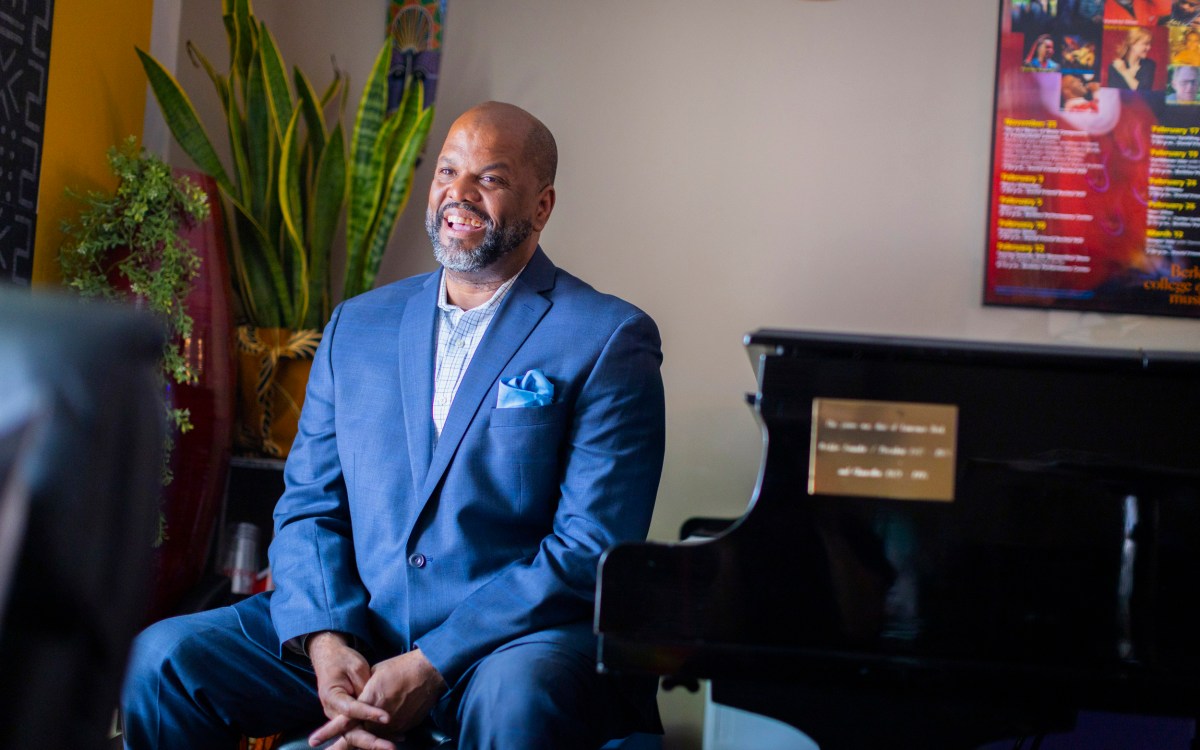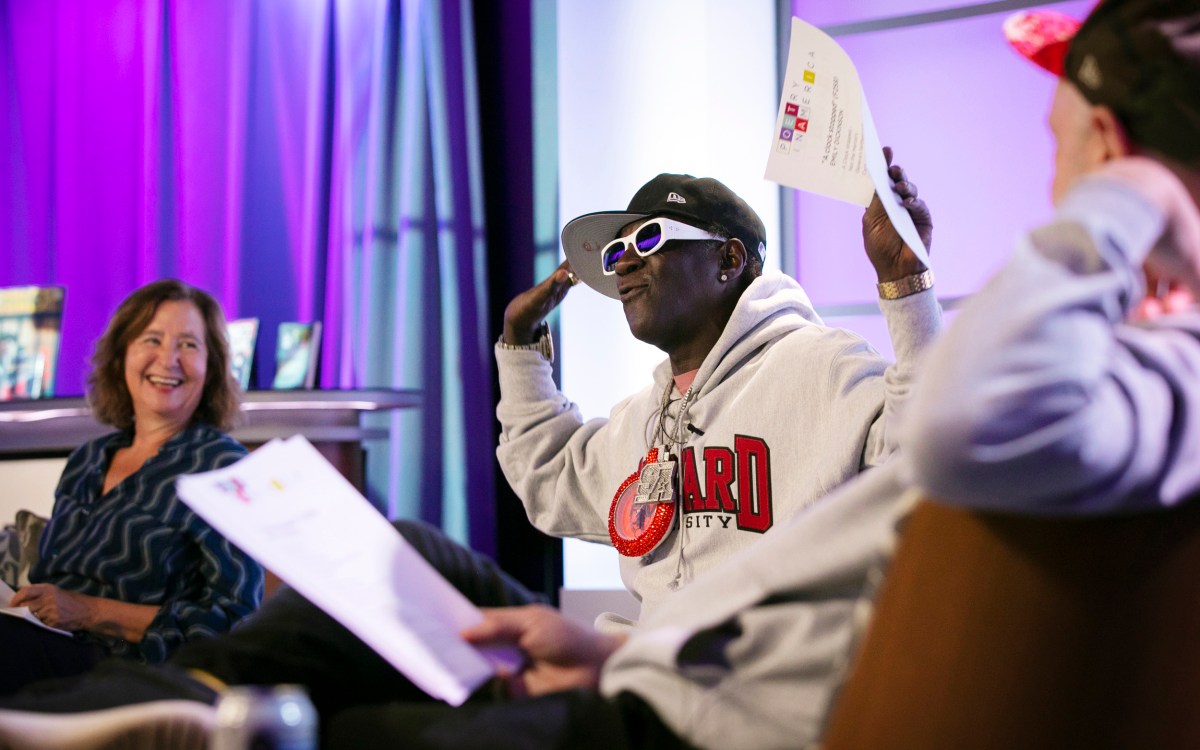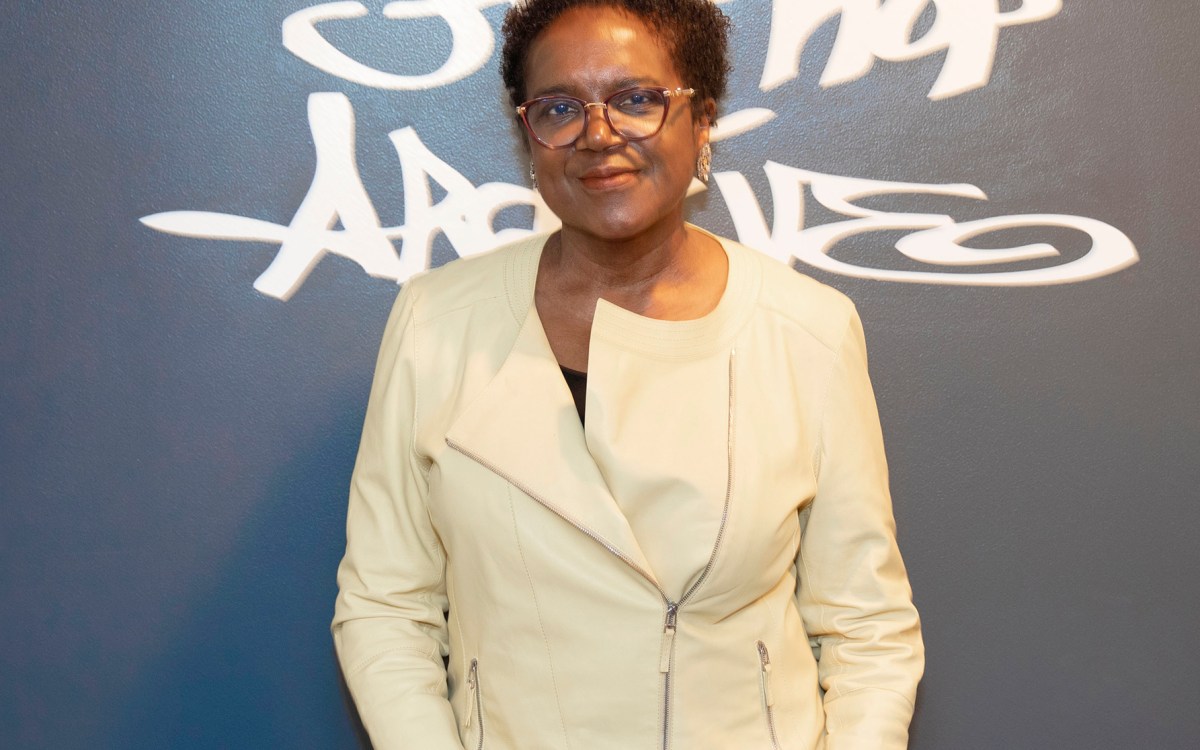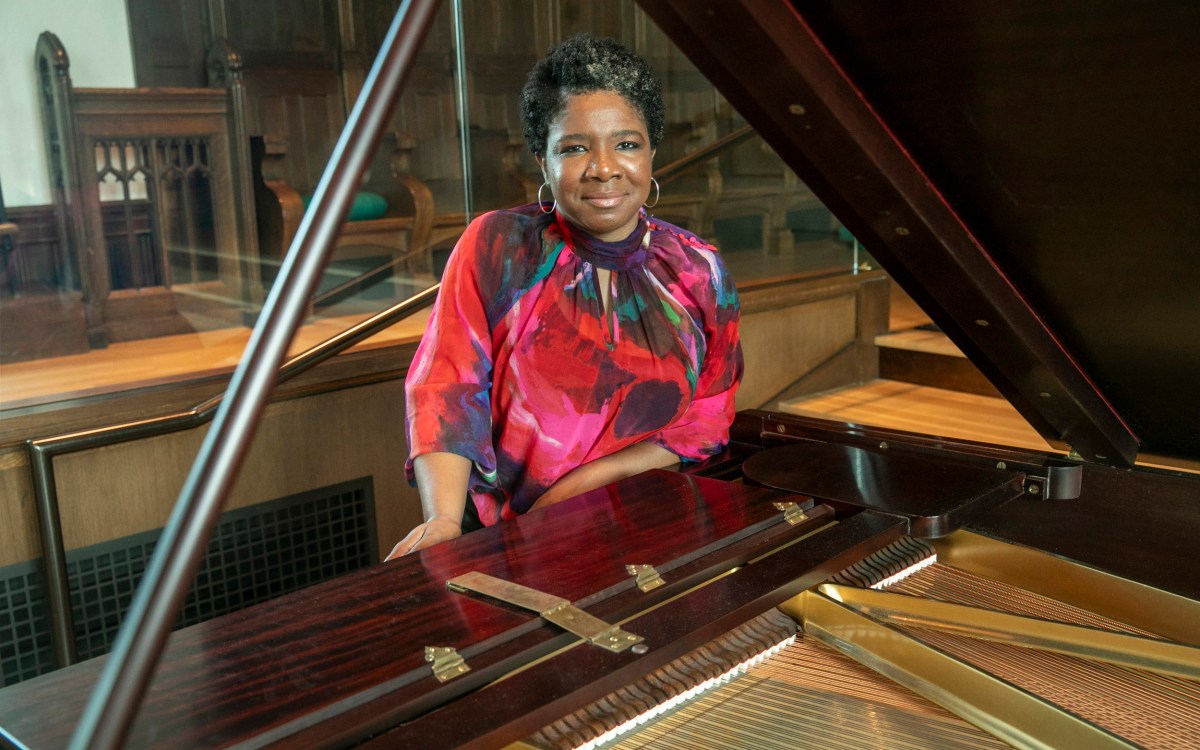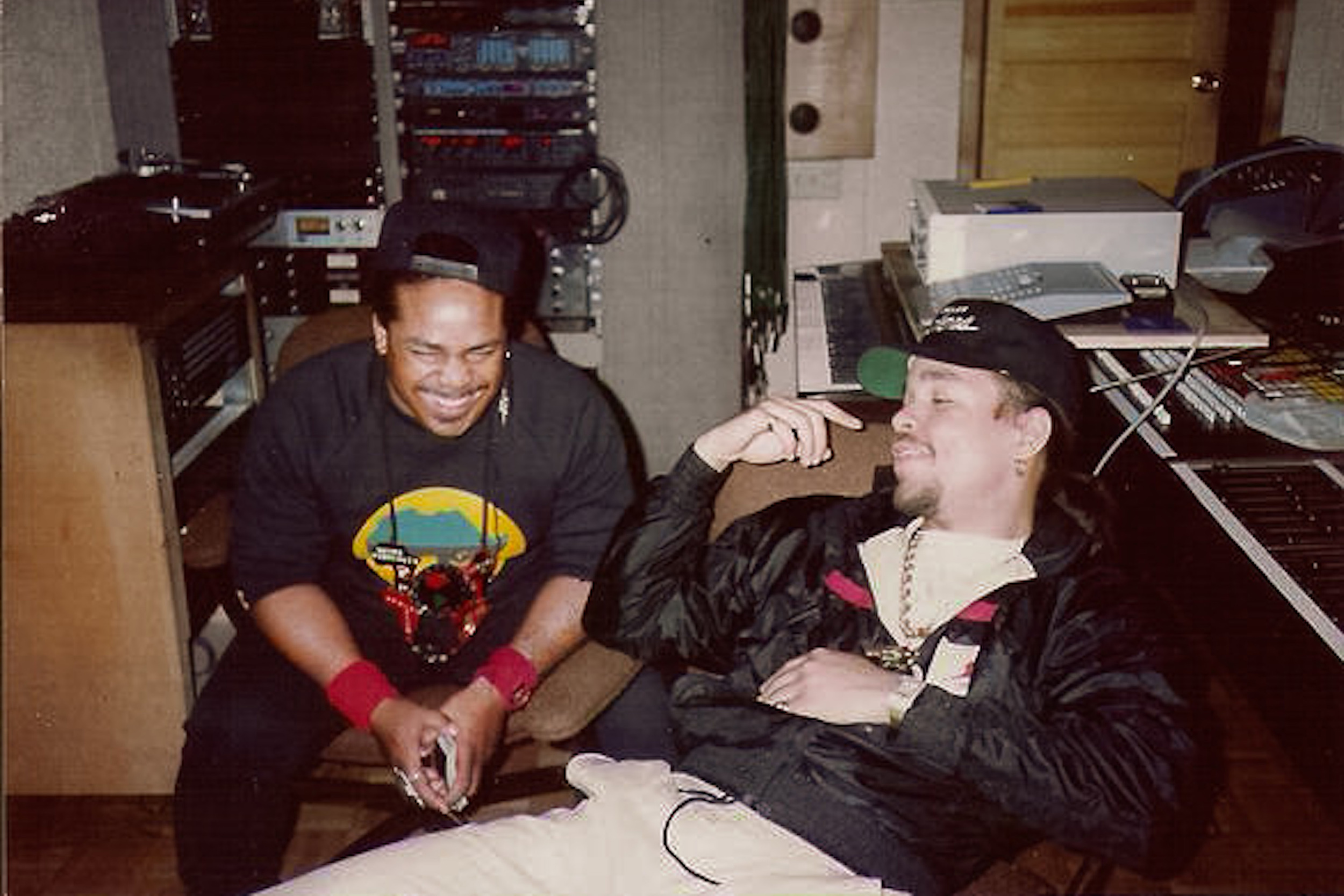
An exhibition opening Friday at the Cooper Gallery draws from the archives of hip-hop pioneers Afrika Islam (left) and Ice T, pictured in the studio in the 1980s.
Photo courtesy of the Ice T Afrika Islam Private Collection at HipHop-History.com
‘We had to create something new — and we did’
Ahead of Harvard visit, two legends of hip-hop recall New York beginnings
When hip-hop was young, there were many avenues for artists to get involved: graffiti, break dancing, MC-ing. With extra ambition, they could even work at becoming one of the genre’s real stars: a DJ.
There was just one thing an emerging hip-hop performer could never be: a copycat.
“We couldn’t bite each other’s moves,” said DJ Afrika Islam, the Bronx-born innovator who remembers participating in battles as a member of the foundational group Zulu Nation. Competing against Grand Wizzard Theodore, the DJ who originated scratching circa 1975, pushed Afrika Islam to devise his own techniques.
“Now everything is Xeroxed and copied and imitated,” Afrika Islam added in a recent phone interview.
“Now you push a button,” said his friend Ice T. “Let AI do it.”
Back then things were different, they agreed. As Afrika Islam put it: “We had to create something new — and we did.”
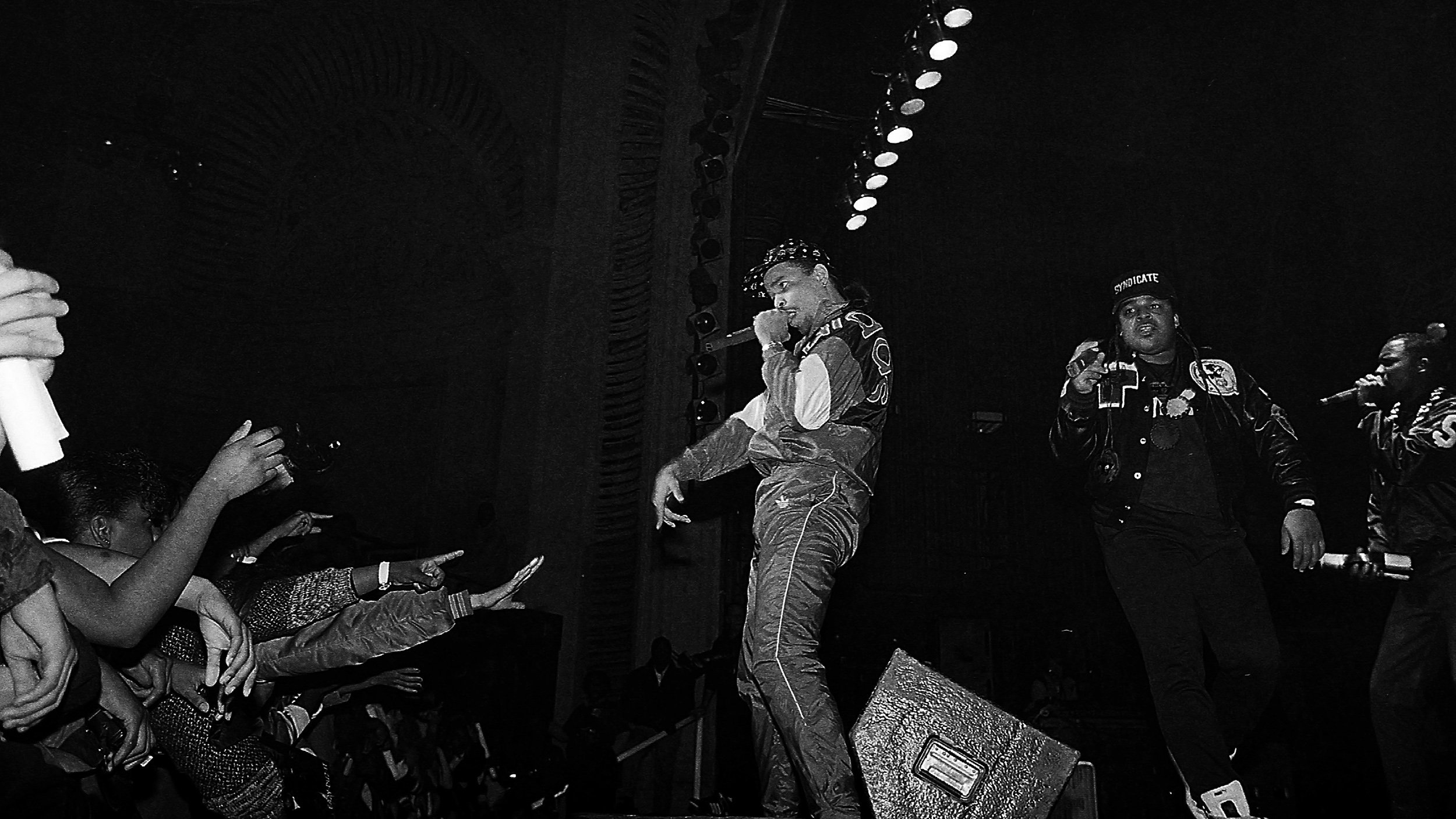
Ice T and Afrika Islam perform at the Riviera Theatre in Chicago in 1989.
Photo By Raymond Boyd/Getty Images
In “Day One DNA: 50 Years in Hiphop Culture,” opening Friday at the Ethelbert Cooper Gallery of African and African American Arts, objects collected by Ice T and Afrika Islam evoke a time when originality ruled. That ethos was central to the rise of hip-hop, the grassroots art and cultural movement invented by Black youth in the Bronx that proved its global staying power over five decades. The multimedia show features everything from early photography and concert footage to the state-of-the-art E-mu SP-1200 drum machine/sampler combo Afrika Islam used to compose much of the music on four Ice T albums.
“The big theme is collaboration,” said exhibition curator Laylah Amatullah Barrayn. “Because this is Ice T and Afrika Islam’s archive together, it tells the story of their friendship, their business partnership, their artistic partnership.”
The pair met in the early ’80s at the Los Angeles venue popularly known as Radiotron, the setting for the movies “Breakin’” and “Breakin’ 2: Electric Boogaloo.” “I wanted to be a rapper,” said Ice T, who served as the club’s MC. “But without getting blessed by anybody from New York, you couldn’t really be a rapper.”
Meeting Afrika Islam, already a top-tier radio and club DJ in New York, opened countless doors for the gangster rap pioneer. Afrika Islam invited Ice T out for a visit, brokering connections with insiders and offering free accommodations at his cramped South Bronx apartment.
The experience was “a culture shock,” Ice T recalled. “I had never been in a tenement. I had never been in a place where two or three people lived on the same floor, shared a bathroom, shared a kitchen.”
“Because this is Ice T and Afrika Islam’s archive together, it tells the story of their friendship, their business partnership, their artistic partnership.”
Laylah Amatullah Barrayn, ‘Day One DNA’ curator
More like this
But Islam’s dwelling, re-created at the Cooper Gallery for an immersive “Day One DNA” experience, provided a trove of inspiration. “His whole room was filled with records,” said Ice T. On display at the gallery are DJ Afrika Islam’s first set of Technics 1200 turntables from the late ’70s and an original Vestax PMC 20SL mixer from 1985. Also featured are more than 900 records from the apartment’s vast collection, so essential to Afrika Islam’s role as a hip-hop originator and virtuoso DJ.
Visitors can sample from this library in a listening station featuring broadcasts from “Zulu Beat,” the world’s first hip-hop radio show, launched in 1982 by Afrika Islam on New York’s WHBI 105.9FM. “Original hip-hop took records from every genre, whether it was funk, jazz, gospel, it didn’t matter,” the DJ offered.
After landing a $40,000 deal with Sire Records, Ice T and Afrika Islam purchased the E-mu SP-1200 and proceeded to record the entirety of “Rhyme Pays” (1987) in that tiny Bronx rental. Ice T’s debut album, brimming with classics like “6 in the Mornin’” and “Make It Funky,” would solidify his status as the first hardcore rapper from the West Coast to gain full acceptance in the birthplace of hip-hop. As the recording’s producer and composer, Afrika Islam is widely credited with refining the rapper’s hard-hitting sound, so distinct from the techno-driven styles that once predominated West Coast hip-hop.
Rounding out the Cooper Gallery display are vintage Marvel posters and an array of martial arts films — on VHS, no less — that influenced both men in their early turns as b-boys (aka break-dancers). Formative books include a biography on the guitar great Jimi Hendrix, and a first edition of “Trick Baby” (1967) by Iceberg Slim, the underground author known for inspiring Ice T’s moniker as well as the first-person narratives that define gangster rap.
“Looking at hip-hop in the ’80s, you really saw the boundlessness of it,” observed Barrayn, who came of age in the era’s Brooklyn scene before pursuing a career in music journalism and photography.
The hip-hop legends will be on campus Saturday for a sold-out roundtable discussion and performance hosted by the Hutchins Center. Joining the duo at Paine Hall will be Grand Wizzard Theodore as well as Melle Mel and Scorpio, both members of Rock & Roll Hall of Famers Grandmaster Flash and the Furious Five.
Also set for the “Hiphop 50” event are DJ Yutaka, a torchbearer for the Japanese scene, and MC Sha-Rock, the first female MC in the history of hip-hop. According to Ice T: “All the people on that panel are first-generation.”



